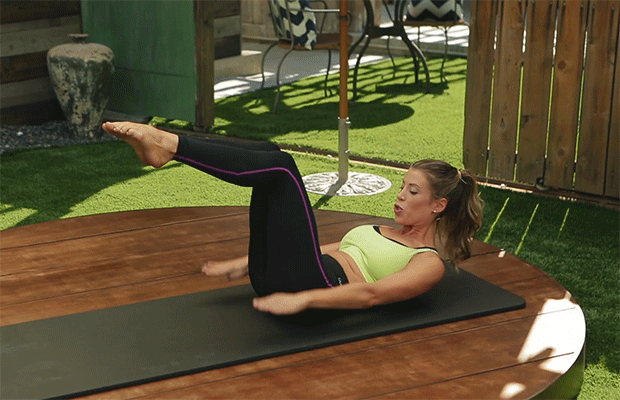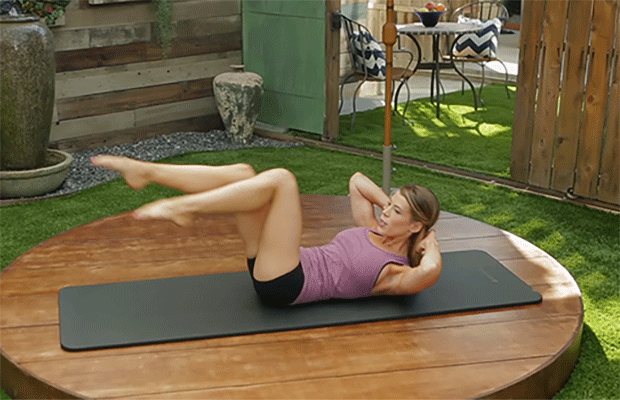Can’t remember the last time you tried to tone your core? Though it might sound intimidating, a Pilates workout could be one way to start developing a stronger center. “One of the best things about Pilates is it is truly for anyone of any level,” says Andrea Speir, Daily Burn Pilates instructor. “Classical Pilates consists of over 600 exercises, all of which have modifications and variations.”
Pilates might imply a pricey studio or fancy equipment to some, but in reality, all you need is a mat. These seven easy Pilates moves require no gear, and are simple enough to try almost anywhere. You’ll find yourself strengthening more than just your core, too. “Pilates is a full-body form of exercise, so everything is getting targeted,” Speir says.
Even if you’ve been skipping out on ab workouts for a while, you can probably still pull off these moves with a few modifications. “In my opinion, it is one of the best things for newbies or people who feel they are out of shape because it will help build a solid base of strength… Everything is based on what your level is and yours alone,” says Speir. Try these seven simple moves to get started today.
7 Core Exercises for a Beginners’ Pilates Workout
1. The 100At the core of every Pilates practice is ‘The 100,’ which is designed to get your blood pumping and warm you up, Speir says. Struggling to make it to the end of this move? “Make this a “50” instead,” Speir advises. “That means inhale for five counts and exhale for five counts. Do that five times. Focus on how much your abdominals are engaging and breathe.”
How to: Draw both legs into your chest, hold on to your legs, curl your head and chest up to a tight ball (a). Send your legs out to a tabletop position with your knee directly above your hip and shins parallel to floor. Hold on behind your thighs and actively curl up, deepening and hollowing out your abs (b). Hover your arms right above your abdominal wall and start to pump your arms 6 to 8 inches up and down, taking deep breaths, inhaling for 5 counts, exhaling for 5 counts (c). Repeat 10 times, without taking a break. Rest your head flat on the floor, rather than curling it up, if the move feels too difficult.
2. Rolling Like a BallDon’t take yourself too seriously. This playful move is actually a simple way to simultaneously massage your back muscles while also working your abs, Speir says. “This exercise is great for beginners because the rounded shape of your spine helps teach you how to properly and effectively engage the core muscles, while challenging them to work hard,” Speir says.
How to: Come into a seated position, knees bent, feet pointed, with just your toes touching the floor (a). Grasp the back of each thigh with each hand, and lift your legs up. Keep your knees shoulder-distance apart, and lower your head between your knees (b). Inhale, exhale, deepening your abdominals, practicing your balance, for two breaths (c). Rock back to your shoulder tips (never onto your head or neck), then back up, finding your balance for a moment. Repeat five times.
3. Single-Leg CirclesWith this simple sequence, you’ll learn how to keep your abs engaged, even when you’re moving your legs. “If you need a little bend in that knee of the circling leg, go for it!” Speir says. “It’s far better to bend that leg than to have your hip lifting up and out of place.” Another tip for first-timers: It may help to bend your non-circling leg, rather than keeping it flat on the mat—this will help you engage your core and align your hips.
How to: Lay down on the mat, shoulders down, ribs down, and extend your right leg straight up to the sky, with the left leg bent, foot flat on the floor (a). Circle your right leg across your body to your left shoulder, than back around to your right shoulder, stop at your nose. Focus on keeping abdominals scooped in (b). Repeat five times, then reverse, and switch legs.
RELATED: The 5-Minute, No-Equipment Back Workout
4. Single-Leg TeaserThe single-leg teaser is an easy way to get your body prepared for the more advanced regular Pilates teaser—in which both legs are extended in the air. Mastering the single-leg teaser first will help you learn how to find and maintain proper form, Speir says. “Make sure your legs are tightly hugging together, even though one leg is extended. You want your knees touching the entire time,” Speir advises. “This midline connection will help the lower abdominals engage and also keep the leg from swinging or dipping around, which makes the exercise more difficult and allows the back and hips to take over.”
How to: Lying on your back, walk your feet in closer together, with your legs at a longer angle (not right in near your hands) (a). Extend one leg out, tightly hugging your inner thighs and knees together (b). Reach your fingers for your toes. Piece by piece, start to slowly round your body up reaching for those toes (c). Roll down only to your shoulder tips, come right back up and reach (d). Repeat four times. Place that foot down, send the other one out, and repeat 4 times.
5. Criss-CrossWho said Pilates had to be complex? You’ll work your entire mid-section with this simple move. “This is one of [my favorite] exercises for building amazing core strength,” Speir says. Having trouble lifting your head? Try rolling up a towel and placing it under your neck. “This will help you see your abdominals and make sure they are probably engaging while in a way imitating the action of having the head and neck up,” Speir says. Remember, you only want to use this modification for moves that require your head and neck to curl up, not any exercises where you’re lying flat on the ground.
How to: Lay on your back, knees pulled into your chest, hands supporting the base of your head (a). Extend your right leg straight in front of you, left leg remains bent. Twist towards your left leg, holding for three counts (b). Switch, extending your left leg straight, pulling your right knee into your body. Spiral your chest towards the right knee, holding for three counts. Repeat twice. Then, do the move faster for four more full rotations (once on each side).
RELATED: 275 Exercises to Shake Up Your Workout Routine
6. SawIf you tend to shy away from traditional ab work (like crunches), this move might be your new go-to. “This exercise helps open and stretch the shoulders and upper back,” Speir says. “This is a must-do for beginners because it establishes a proper base and form for the body. It also builds strength, while giving a good juicy stretch.”
How to: Sit up, legs spread as wide as a yoga mat (a). With your arms straight out to your sides, twist to your left (b). Stretch your right hand towards your left foot, pulsing three times (c). Roll up in the twist, untwist, and return to center. Repeat on the opposite side. Repeat once more on each side.
7. MermaidThis stretch gives some much-needed attention to the sides of your body, which rarely get the TLC they deserve, Speir says. “Not only does it feel fantastic but it will help relieve tension and lengthen out your body.”
How to: Rest on your right hip in a seated position, with your legs folded together to the left side (like a mermaid!) (a). Place your left hand around your ankles, and hold your right arm straight up in the air, grazing your ear (b). Keeping your abdominals engaged, reach your right arm towards the ceiling, and then out and over to the left, making sure your arm stays straight. You should feel a stretch along the right side of your body. Repeat twice (c).For a counter-stretch, place your right hand on the mat, bending it slightly (d). Lift your left arm up near your ear, and stretch to the right. Spin your legs around, and repeat on the opposite side.
This article originally appeared on DailyBurn.com.







